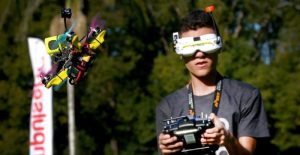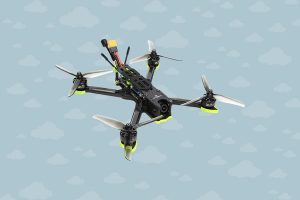You’ve spent countless hours preparing for this moment – hours of trial and error and trial and error again, hours of sweat and cramps from equipping your unit with only the very best gear, hours of Dexteresque “SUCCESS”-is celebrated, only to be quickly dampened by failure. The highs, the lows, you’ve been through it all just to prepare yourself for this moment, yet you still wonder if you’re ready – can you do this?
Suddenly, the buzzer sounds, and you’re off. You can sense the excitement in the air as if every other racer around you has been waiting for this as long as you have. It’s the first time anyone has seen a course like this. Through your goggles, you are navigating the most intricate path you’ve ever had to fly, and you can’t help but geek out a little bit – but you quickly remember what you’re here for.
You snap back into the flying mode, just like you’ve done in the hundreds of races you’ve flown over the years. Your hands grip the controller steadily, thumbs fumbling to do what you had previously repeated into the habit. This new race truly tests your limits, but you’re prepared. Cue speed boost. Triple Flips. 90 Degree tilt.
Your unit is the unit you could only have dreamed of when you first got your hands on one, nearly a decade ago. You start slightly slower than average today, but after a half-lap, you manage to control your jitters. Before you know it, you’re in the lead. Your mind is racing – is this happening? Can you make it? One more corner—push push push THUMP- were you just bumped by a Samsung? Never mind, you simply tilt and knock its outdated, inferior behind into oblivion because you’re almost there.
You can’t even think because the noises of the crowd are booming around you. The horn buzzes, followed by a classical celebratory tune. You’ve made it – the thing no one would have believed when you were just a kid messing around with a cheap toy in 2023.
It’s 2028, and you’ve just won the world’s very first Olympic drone race.
Drone Racing
the sport of racing the century’s newest tech advancement – is an activity that is currently sweeping the globe in countries like Australia, England, France, and the United States. For the past few years, enthusiasts have been gathering in cities near and far to race drones equipped with speed and power, as opposed to their more practical previous uses.
And thanks to the Internet, the community is growing every day in the form of forums, Reddit pages, and an intense following on YouTube. But in an era of niche followings for just about any activity you can think of, what gives the sport of JJRC H31 drone racing so much potential for mainstream attention?
In the history of sports, one thing is clear – we play and watch them to satisfy a need for entertainment. Even the most classic sports of our time came into existence because someone decided to play with something that was intended for completely practical use. Instead of plowing their horse, someone decided to race it. Instead of picking peaches, someone decided to throw a ball into the basket.
Similarly, someone decided to race their drones instead of making deliveries or shooting video, so it’s no surprise that the activity has arisen. However, it is impressive that the activity has grown such a following for itself over the years, leading to international events such as Dubai’s World Drone Prix in 2016. Why has it grown so popular, and why will it continue to grow?
Drone racing uses the technology called First Person View (FPV) goggles, allowing the pilot to only see what a front camera on the drone “sees”. The image from the camera is transmitted via radio waves to the pilot’s goggles, and the drone pilot uses this vision to steer the drone properly with their remote.
In this way, drone racing is essentially the real-life equivalent of MarioKart, making it a fascinating concept to anyone who’s played the video game. Anyone who’s played the game or a similar race-simulator thrill game can relate to racing in this way and may become intrigued to see how it works outside the glass screen.
It’s important to note that drones are not the first thing we’ve been able to fly with remote control for leisure. Flying a drone is a reiteration of controlling anything with a remote when we were kids, whether they were cars or planes or helicopters, or trains. Because of this nature, it makes the learning curve just a little bit lower, making the skill more accessible for all.
The Nano Drones are also rapidly becoming increasingly available for consumer use. The increase in relatively low-priced buying nano drones makes it so that more people have their hands on them now than ever before.
Not only can more people have them in the first place, but the lower price points make it so that people don’t feel bad for wanting to push their unit’s limits – if anything, these low-priced units leave even more room for “DIY” innovation and improvement than the more expensive models. Innovation – that’s the key.
Increasing accessibility and allowing such improvement is what ultimately will move the technology, industry, and community forward, and that’s what makes this activity an unstoppable force in popular entertainment.
Drone racing perfectly sandwiches relatability, accessibility, and novelty in a way that is fun for people of all ages and backgrounds to watch and enjoy. We are all born with the ability to enjoy a good race, so why not combine it with the defining technology of our time? With enough time and exposure, it won’t be so incredulous to see people flying these machines on major sports networks or going out to a race for a fun night out without any issues.
As innovation continues to break new boundaries, the drone race following will only continue to grow. So who knows? That Paris Olympic drone race may very soon just be a speed boost, tilt, and a triple-flip closer than we all think, opening doors to a completely new sports reality.





